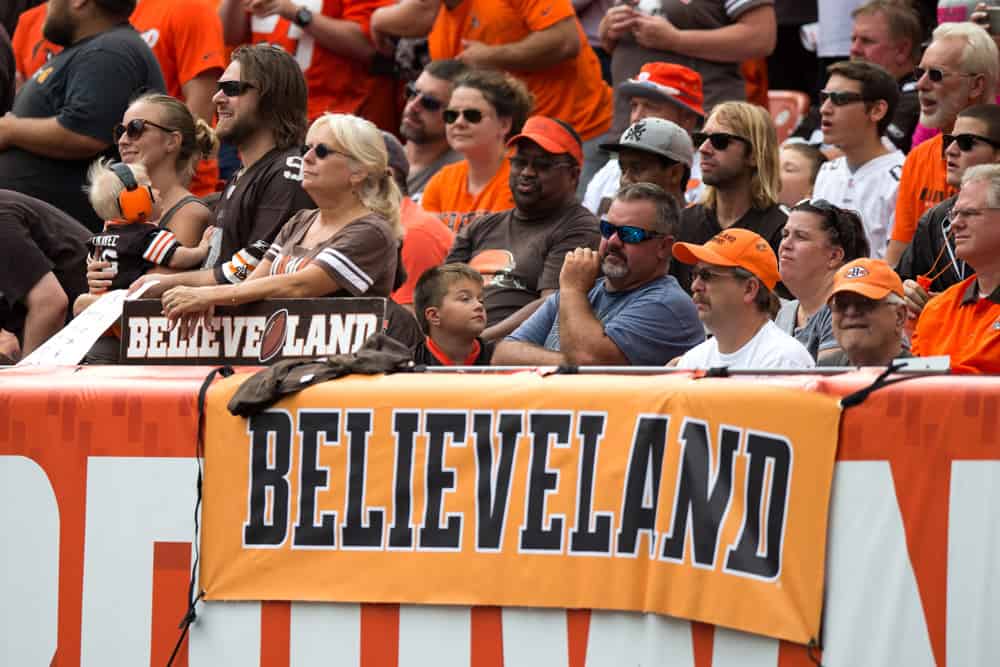Why do the Browns have an elf mascot?
Football team mascots and names are often quite confusing and have mysterious origins.
And Brownie the Elf is, perhaps, one of the strangest mascots in football history.
Brownie has been the on-again-off-again mascot of the Cleveland Browns for close to 80 years.
Where did this peculiar elf originate, and why do Cleveland residents love him so much?
Brownie Has An Early Beginning
After the formation of the Cleveland Browns in 1946, the team went on to dominate for four seasons and become one of the most respected organizations in the AAFC.
Owner Arthur McBride was pleased with this success, and with the flow of income, the team generated.
However, he was always looking for ways to make his team more prominent and to help them stand out in an increasingly popular sport.
Although McBride was a very hands-off owner when it came to running the actual team – coach Paul Brown was, in essence, the general manager who also made all player and play-making decisions – McBride had his moments when he tried to improve his team’s visibility.
As a result, he asked for submissions from the residents of Cleveland for mascot logos that could help the team stand out.
This step was understandable when one considers the name of the team and the common mascot approach of other organizations.
Take, for instance, the nearby Detroit Lions.
The simplicity of this name made it easy to come up with a memorable mascot, one that still makes Detroit an easy team to recognize on the field today.
However, the name “The Browns” didn’t bring to mind any distinct image to market the club.
After receiving multiple submissions that were quite promising, McBride chose Brownie the Elf as the face of the team.
The earliest known version of Brownie was on 1946 tickets for a game against the Miami Seahawks, showing that Brownie had been in the works for some time.
Many believe that the elf was designed by Dick Dugan, a sports cartoonist for the Cleveland Plain Dealer.
Threats to Brownie
Brownie was an almost instant hit with fans in Cleveland.
You can see replications of the elf in various publications and advertisements for the team throughout this period.
Fans often came to games dressed in his trademark image – pointed shoes and Browns gears.
Variations of Brownie were developed over the years, with a significant makeover in 1950 that lasted until 1969.
However, not everybody was a fan of Brownie the Elf, such as second Browns’ owner Art Modell.
Modell – who was a very hands-on owner who made many good and bad decisions for the team – found Brownie embarrassing.
In 1961, he started trying to phase out Brownie and, in 1969, Brownie was gone from the team for good.
This move upset many fans at the time, though not quite as much as when Modell moved the team to Baltimore in the mid-1990s.
During the years without Brownie, the team created the Dawg Pound concept and used dog-related mascots like Chomps, to market the club.
This mascot made more sense for a football team, as it was a more imposing character than an elf.
However, there were many old-school fans and even modern ones who missed Brownie and who were delighted when the team came back in 1999 with Brownie as their mascot.
Brownie’s Return
The unique deal made by Modell upon leaving Cleveland allowed the town to recreate the team – with the same records, mascots, colors, and logos – if somebody purchased the team rights.
In 1999, businessman Randy Lerner purchased these rights and brought football back to Cleveland.
Residents rejoiced and were particularly pleased when Lerner showed proper respect for history by bringing back Brownie the elf as the team mascot.
At the time, Lerner said that Brownie was a “great anchor for our tradition and for the look and feel of the Browns.”
Since then, Brownie has been on the sideline of games and used in many promotional materials.
For example, Brownie was used to celebrate the franchise’s 60th anniversary in 2006.
The design during this year reflected the original look of Brownie, which many fans loved.
And Brownies’ return looks permanent, in spite of a few amusing April Fool’s Day jokes claiming that the team was phasing him out again.
Just don’t ever expect to see Brownie on the team’s helmets – though this idea was once teased early in the team’s history, Paul Brown and the players on his team couldn’t entirely take the design seriously.
And coaches and owners since have honored that decision and remain committed to the simple helmet design of their team.
NEXT: Jim Brown History | Complete Profile and Career Highlights